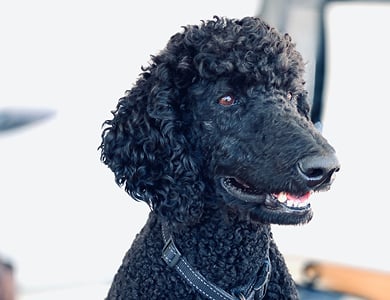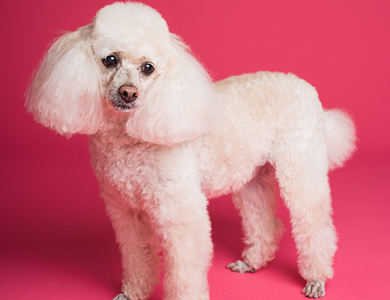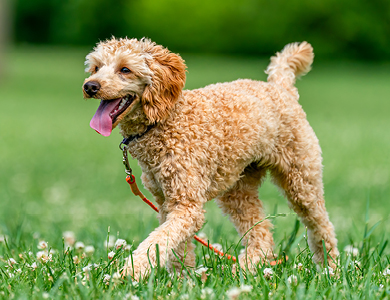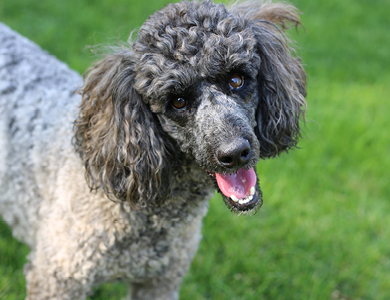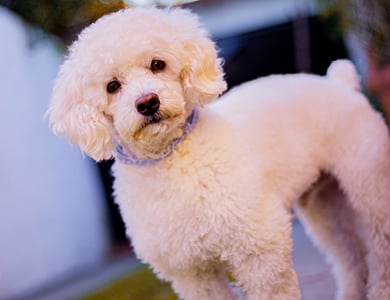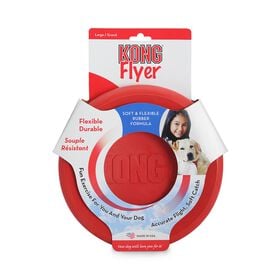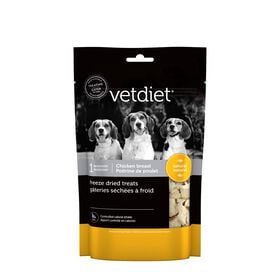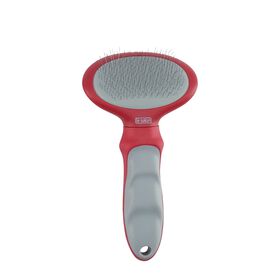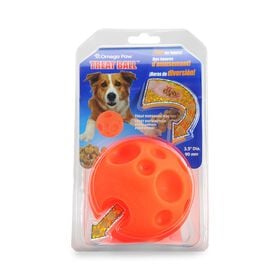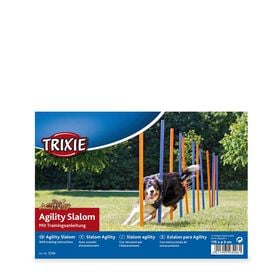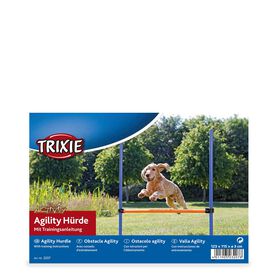Considered one of the most intelligent dog breeds in the world (second only to the border collie), the poodle, known as caniche in French, is much more than a dog with pom-poms. In fact, the poodle is one of the oldest retriever breeds. The pom-poms, which some poodles still wear today, were originally meant to keep the dogs’ joints and vital organs warm while they retrieved ducks from the cold water.
Physical appearance
The poodle is a very active, energetic, clever, elegant, squarely built, well-proportioned dog that carries itself proudly. A carefully groomed poodle has a particular air of elegance and dignity. The poodle is a dog breed that comes in three size varieties: standard, miniature and toy. The terms teacup and tiny toy are used strictly for marketing purposes. These extremely small dogs are very likely to develop health problems.
The standard poodle, originally used by hunters, is the oldest of the three poodle varieties, and was later bred down to the miniature and toy sizes. The breed standards are the same for all three varieties, except with regard to height.
The standard poodle should be at least 38.1 cm (15 in.) tall at the withers; the miniature poodle, between 25.4 cm (10 in.) and 38.1 cm (15 in.), and the toy poodle, 25.4 cm (10 in.) or less. Underneath its curly coat, the poodle is an athletic and elegant dog. Its muzzle is long, straight and fine, but strong, with the lips firmly fitted. It has a square body shape, with a deep and moderately wide chest and well-sprung ribs. The length of the body, measured from the sternum to the tip of the coccyx, essentially equals the height at the highest point of the withers. Although the tail is generally docked, breeders are increasingly leaving the tail its natural length.
Poodles come in many colours, such as black and white, but also various shades of grey, brown, apricot and cream. Parti-coloured poodles, whose coats are different colours, are not recognized in North America. In France, however, these dogs are recognized as purebred, and referred to as curly-haired parti-coloured dogs.
Life expectancy and health
The average lifespan of a poodle is 12 to 16 years, although many live more than 15 years and some up to 18 or 19 years. Like many large breeds, the standard poodle has a slightly shorter lifespan than miniatures and toys, but only by a few years.
Although the breed is generally quite healthy, poodles are prone to specific health problems that should not be neglected, such as hip dysplasia, progressive retinal atrophy, epilepsy, Addison’s disease, thyroid problems, hypoglycemia, gastric torsion (dog bloat) and collapsed trachea. Serious and conscientious breeders do the necessary screening tests to ensure that the parents of their future puppies are not affected by these genetic conditions. With regard to gastric torsion, however, prevention is the only solution.
Energy level and temperament
Poodles are easy to train, despite their strong personality. They are also recognized for being highly intelligent. Poodles of all sizes are very active dogs that require daily exercise. They enjoy all kinds of activity and like to be busy. Whether they are involved in such canine sports as agility, canicross or obedience, poodles will be happy if both their mind and body are stimulated. Swimming is also an ideal exercise for them, and most poodles love to get in the water. Bred as hunting dogs, they are natural retrievers, so having them fetch toys, sticks and balls will exercise both their mind and body. Poodles are affectionate dogs that like to please, and make excellent family pets. It is, however, important to take precautions with young children when dealing with miniature or toy poodles because of their smaller size.
Maintenance and grooming
Not all owners of this breed agree on the typical poodle look, complete with pom-poms. Some prefer the teddy bear look, while others like the more sophisticated look of a typical clip. Whatever your preference, you will need to learn how to brush your poodle daily to avoid tangles, unless you plan to keep its coat very short.
Unlike most dogs with a double coat, poodles have no undercoat. They have a tightly curled coat that sheds very little. As a result, poodles are often considered hypoallergenic, even though they are not entirely allergen-free dogs. It’s important to remember that failing to brush and comb your dog’s coat all the way down to the skin will cause the hair to become matted near the roots, and the dog will have to be shaved to avoid skin problems.
Most owners choose to keep their poodle’s coat short, unless the dog is taking part in a conformation competition where the typical cut is mandatory. Some owners do the clipping and trimming themselves, while others choose to take their dog to a professional groomer every four to six weeks for a bath, grooming and nail clipping.
Origins
The Fédération Cynologique Internationale, the international organization of which both France and Germany’s main kennel clubs are members, claims the breed descends from the French barbet. The progenitor of the breed might also have been crossed with the Hungarian puli. However, the Canadian Kennel Club states that the breed originates in Germany. The French name caniche comes from the word cane (the female of the duck), since this type of breed was used as a water retriever for duck hunting.
Despite the poodle’s association with France, the breed originated as a duck hunter in Germany, where the word pudelin refers to splashing in water. The standard poodle began its development as a retriever water dog more than 400 years ago. Drawings by German artist Albrecht Dürer established the popular image of the breed in the 15th and 16th centuries. Similarly, a 1631 self-portrait of Rembrandt with his pet poodle in the foreground helped define the dog’s image.
Since hunting was a pastime for the rich in most European countries, the poodle was naturally prized by the wealthy and the monarchy. The trend continued until the end of the French monarchy in the 18th century, with the last three kings of France each owning at least one poodle. At that time, the smaller poodle varieties began to appear in portraits and records at Versailles as pets of the kings and their courtiers.
The miniature and toy varieties were developed in England in the 18th century mainly as pets. Some sources suggest that smaller varieties such as the miniature may have been popular for truffle hunting, since their feet were less likely to damage the delicate fungi. The poodle remained a dog of the bourgeoisie and upper classes throughout the 19th century before becoming a popular breed for pets of the middle class.
For more information, contact a registered breeder at the Canadian Kennel Club, who can answer all your questions. You can also contact the organization for information on breeders and the various breed clubs in Quebec and elsewhere in Canada.


